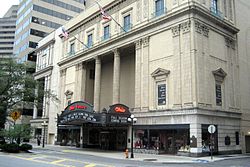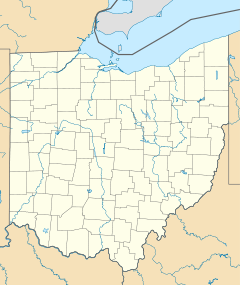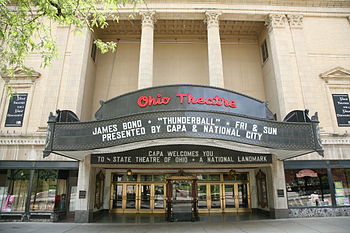- Ohio Theatre (Columbus, Ohio)
-
For other uses, see Ohio Theatre (disambiguation).Ohio Theatre
 The Ohio Theatre
The Ohio TheatreLocation: Columbus, Ohio Coordinates: 39°57′37″N 82°59′56″W / 39.96028°N 82.99889°WCoordinates: 39°57′37″N 82°59′56″W / 39.96028°N 82.99889°W Built: 1927 Architect: Thomas W. Lamb Architectural style: Spanish baroque Governing body: Private MPS: Columbus MRA NRHP Reference#: 73001437[1] Added to NRHP: May 5, 1977 The Ohio Theatre is a performing arts center located at 39 E. State Street in Columbus, Ohio. Known as the "Official Theatre of the State of Ohio", the historic 1928 movie palace was saved from demolition in 1969 and completely restored. It was declared a National Historic Landmark in 1977.[2]
The Ohio Theatre is owned and operated by the non-profit arts management organization CAPA (The Columbus Association for the Performing Arts), which was originally formed to save the theater in 1969. The executive director is Bill Connor.
Contents
History
Loew's Ohio
Located in Downtown Columbus on the site of the old Columbus City Hall, the Ohio Theatre was designed by the noted theatre architect Thomas W. Lamb. Of all of the theaters he designed, he noted the Ohio as one of his most successful. He intended to separate patrons from their daily lives by creating a luxurious fantasy atmosphere inside. It was furnished by New York decorator Anne Dornan. Each room had a theme. Dornan's favorite was the "Africa Corner" which she decorated with authentic pieces from her travels. The theatre also featured lavish men's and women's lounge areas including separate smoking and telephone rooms.[3]
Built by the Loew's theater chain in partnership with United Artists the 2,779 (originally 3,096) seat Spanish Baroque movie palace opened on March 17, 1928. The first film shown there was The Divine Woman, a silent film with Greta Garbo. The Ohio featured its own orchestra and Robert-Morton theatre organ (still in use today). In addition to movies, deluxe variety shows graced the stage, with performers that included Fred Waring, Milton Berle, Ray Bolger, Buddy Ebsen, Ginger Rogers, Conrad Nagel, and Jack Benny.
Sound films were introduced at Loew's Ohio in August 1928. The great popularity of "talking pictures" reduced the need for theater chains to offer expensive live entertainment along with the films. Regular stage shows were discontinued in 1933 and the orchestra was disbanded. However organist Roger Garrett continued to perform daily at the "Mighty Morton" and occasional live appearances by stars including Judy Garland and Jean Harlow were featured on the stage. The theater was the premiere area showcase for the films of MGM and other studios and in the late 1930s double features became the norm. Programs ran for one week with the rare exception of huge hits like Gone with the Wind, which ran for three.
During World War II, movie theaters were busier than ever and the Ohio was no exception, adding late night showings for war plant shift workers. War bonds were heavily promoted and sold in the theater's lobby. In 1944, when Roger Garrett was inducted into the army, live organ music was discontinued.
In the late 1940s when television became popular, movie attendance gradually dropped as audiences lost the weekly moviegoing habit. Attendance further decreased when residents began moving from the city to the suburbs. The decreased profits led to a decreased staff and roped off seating. However the Ohio continued showing premium films until it closed. The James Bond films were especially popular for the theater in the 1960s. In 1966, members of the American Theatre Organ Society began restoring the Robert Morton and playing the organ for shows again.[3]
Restoration and rebirth
Loew's closed the theater on February 24, 1969; the final film shown was Play Dirty with Michael Caine. A local development company called the 55 East State Company bought the theater with plans to build an office tower on the site of the Ohio and the adjacent Grand Theatre. Members of the community rallied to raise money to purchase an option to purchase the building to buy time to raise money and keep the theater open. Some of the non-essential interior items were sold to raise money to buy the property. Under the leadership of architect Robert Karlsberger and others, the non-profit Columbus Association for the Performing Arts (CAPA) was formed to raise money and develop a plan for the future of the theater. All the while live performances were held inside to raise money and give the public a chance to see theater in use.[3]
CAPA was able to use the groundswell of popular interest in the theater to convince business and government leaders to support saving the theater. In late 1969 money was raised to purchase the Ohio and it immediately began presenting shows and concerts under the management of CAPA. The Columbus Symphony Orchestra badly needed a new permanent home and began performing at the Ohio in the fall of 1969, enjoying an increase in ticket sales thanks to excitement about the new venue.
The original building was completely restored to its original appearance in stages throughout the 1970s. The attached Grand Theatre was demolished and the adjacent lot was developed at first for parking. Then in the 1980s an adjacent building with expanded lobby space as well as offices and rehearsal rooms for the theater was built with support from the Galbreath Company. The stage was gradually modernized to allow for large theatrical performances which included adding a crossover passage, supplemental dressing rooms and a larger orchestra pit.[3] In the 1980s as the surrounding area was cleared for development of an urban shopping mall, CAPA obtained the rights to expand the stage, doubling its size, into the alleyway behind the theater. Additional dressing rooms and a loading dock were also built bringing the Ohio's stage facilities to modern standards and allowing the presentation of large touring Broadway musicals.
The Ohio Theatre was one of the earliest restorations of a movie palace for use as a performing arts center and served as a model for many later historic renovation projects in the United States. Unlike many remaining 1920s theaters designed by Lamb and others, the Ohio still very closely resembles its original appearance with only a few modern additions. Today it is the home of the Columbus Symphony Orchestra, BalletMet, the Broadway Series, Opera Columbus, and the CAPA Summer Movie Series.
See also
References
- ^ "National Register Information System". National Register of Historic Places. National Park Service. 2007-01-23. http://nrhp.focus.nps.gov/natreg/docs/All_Data.html.
- ^ http://www.nps.gov/nhl/designations/Lists/OH01.pdf
- ^ a b c d Bishop, Mary; et. al. (1978). The Ohio Theatre: 1928- 1978. Columbus Association of Performing Arts.
External links
- Official CAPA website. Short history of theatre.
- Library of Congress. Historic American Buildings Survey record, with plans and early photos.
- National Register of Historic Places listing.[dead link]
U.S. National Register of Historic Places Topics Lists by states Alabama • Alaska • Arizona • Arkansas • California • Colorado • Connecticut • Delaware • Florida • Georgia • Hawaii • Idaho • Illinois • Indiana • Iowa • Kansas • Kentucky • Louisiana • Maine • Maryland • Massachusetts • Michigan • Minnesota • Mississippi • Missouri • Montana • Nebraska • Nevada • New Hampshire • New Jersey • New Mexico • New York • North Carolina • North Dakota • Ohio • Oklahoma • Oregon • Pennsylvania • Rhode Island • South Carolina • South Dakota • Tennessee • Texas • Utah • Vermont • Virginia • Washington • West Virginia • Wisconsin • WyomingLists by territories Lists by associated states Other  Category:National Register of Historic Places •
Category:National Register of Historic Places •  Portal:National Register of Historic PlacesCategories:
Portal:National Register of Historic PlacesCategories:- NRHP articles with dead external links
- Concert halls in the United States
- Landmarks in Ohio
- Movie palaces
- National Historic Landmarks in Ohio
- Theatres in Columbus, Ohio
- 1928 architecture
Wikimedia Foundation. 2010.



